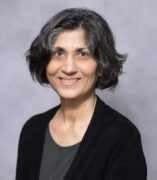
Anjum Ansari, PhD
Professor
Physics
Contact
Building & Room:
2612 SES
Address:
845 West Taylor St.
Office Phone:
Email:
Related Sites:
About
The broad aims of Prof. Ansari’s research program are to capture the dynamics of constantly fluctuating conformations of biological macromolecules and to elucidate the role of these fluctuations in macromolecular interactions that are central to biology. Using sophisticated time-resolved fluorescence spectroscopy approaches, her group has made important contributions in two distinct subfields in biological physics: 1) dynamics and mechanisms of nucleic acid folding; and 2) dynamics of protein-DNA interactions and mechanisms of ‘target site’ recognition.
Her studies on the formation of hairpins and pseudoknots in nucleic acids provide a foundation for interpreting the timescales on which these structures form and serve as critical benchmarks for validating computational studies. Her group pioneered the application of laser temperature-jump (T-jump) to measure conformational dynamics in proteins and DNA when they interact and bind. DNA-binding proteins such as those involved in gene regulation or DNA repair often bend, kink, or otherwise deform DNA at the specific target sites, and kinetics measurements of conformational changes that confer recognition are essential for understanding the underlying molecular mechanism. Her laser T-jump studies, together with complementary approaches such as fluorescence lifetime and correlation spectroscopy, unveiled key steps such as DNA unwinding, bending, and nucleotide flipping on timescales not readily accessible by other techniques. The current focus in her group is to examine site recognition in the biologically relevant context of looped and supercoiled DNA, which remains largely unexplored.
Prior to joining UIC, Prof. Ansari was a postdoctoral fellow with Dr. William A. Eaton at the Laboratory of Chemical Physics, National Institutes of Health, and received her Ph.D. with Prof. Hans Frauenfelder at the University of Illinois at Urbana-Champaign.
Selected Publications
“Flexible hinge” dynamics in mismatched DNA revealed by fluorescence correlation spectroscopy. T. Ten, V. Zvoda, M. K. Sarangi, S. V. Kuznetsov, and A. Ansari, J. Biol. Phys. 48, 253 (2022). doi.org/10.1007/s10867-022-09607-x
Thermodynamics of unfolding mechanisms of mouse mammary tumor virus pseudoknot from a coarse-grained loop-entropy model. K. Tang, J. Roca, R. Chen, A. Ansari, and J. Liang, J. Biol. Phys. 48, 129 (2022). doi.org/10.1007/s10867-022-09602-2.
Tethering-facilitated DNA ‘opening’ and complementary roles of β-hairpin motifs in the Rad4/XPC DNA damage sensor protein. D. Paul, H. Mu, A. Tavakoli, Q. Dai, X. Chen, S. Chakraborty, C. He, A. Ansari, S. Broyde, and J. H. Min, Nucleic Acids Res. 48, 12348 (2020). doi.org/10.1093/nar/gkaa909
Evidence for a bind-then-bend mechanism for architectural DNA binding protein yNhp6A. M. K. Sarangi, V. Zvoda, M. N. Holte, N. A. Becker, J. P. Peters, L. J. Maher, and A. Ansari, Nucleic Acids Res. 47, 2871 (2019). doi.org/10.1093/nar/gkz022
Static kinks or flexible hinges: multiple conformations of bent DNA bound to Integration Host Factor revealed by fluorescence lifetime measurements. M. Connolly, A. Arra, V. Zvoda, P. J. Steinbach, P. A. Rice, and A. Ansari, J. Phys. Chem. B. 122, 11519 (2018). doi.org/10.1021/acs.jpcb.8b07405
Monovalent ions modulate the flux through multiple folding pathways of an RNA pseudoknot. J. Roca, N. Hori, S. Baral, Y. Velmurugu, R. Narayanan, P. Narayanan, D. Thirumalai, and A. Ansari, Proc. Natl. Acad. Sci. U S A. 115, E7313 (2018). doi.org/10.1073/pnas.1717582115
Two-step interrogation then recognition of DNA binding site by Integration Host Factor: an architectural DNA-bending protein. Y. Velmurugu, P. Vivas, M. Connolly, S. V. Kuznetsov, P. A. Rice, and A. Ansari, Nucleic Acids Res. 46, 1741 (2018). doi.org/10.1093/nar/gkx1215
Enhanced spontaneous DNA twisting/bending fluctuations unveiled by fluorescence lifetime distributions promote mismatch recognition by the Rad4 nucleotide excision repair complex. S. Chakraborty, P. J. Steinbach, D. Paul, H. Mu, S. Broyde, J. H. Min, and A. Ansari, Nucleic Acids Res. 46, 1240 (2018). doi.org/10.1093/nar/gkx1216
Twist-open mechanism of DNA damage recognition by the Rad4/XPC nucleotide excision repair complex. Y. Velmurugu, X. Chen, P. Slogoff Sevilla, J. H. Min, and A. Ansari, Proc. Natl. Acad. Sci. USA 113, E2296 (2016). doi.org/10.1073/pnas.1514666113
Kinetic gating mechanism of DNA damage recognition by Rad4/XPC. X. Chen, Y. Velmurugu, G. Zheng, B. Park, Y. Shim, Y. Kim, L. Liu, B. Van Houten, C. He, A. Ansari, and J. H. Min, Nat. Comm. 6, 5849 (2015). doi.org/10.1038/ncomms6849
A kinetic zipper model with intrachain interactions applied to nucleic acid hairpin folding kinetics. S. V. Kuznetsov and A. Ansari, Biophys. J. 102, 101 (2012). doi.org/10.1016/j.bpj.2011.11.4017
Exploring the energy landscape of nucleic acid hairpins: a laser temperature-jump and microfluidic mixing study. R. Narayanan, L. Zhu, Y. Velmurugu, J. Roca, S. V. Kuznetsov, G. Prehna, L. J. Lapidus, and A. Ansari, J. Am. Chem. Soc. 134, 18952 (2012). doi.org/10.1021/ja301218e
Education
BS, Physics (1981), Indian Institute of Technology
MS, Physics (1982), University of Illinois at Urbana-Champaign
PhD, Physics (1988), University of Illinois at Urbana-Champaign